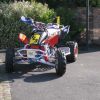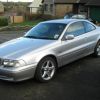My 05MY V70R AWD is now eating discs (front and rear). Was fine for first 4 years on original discs but now doing high m'way miles (as using for compnay car replacement to keep HMRC off my back) and warping starts after around 3 months use, no matter what I do to try and hold it off...
Local dealer service manager flummoxed, Volvo don't want to know as it's past 5 year warranty but as I contribute £40 for each set of discs to get 12 months warranty, I am slowly getting the feeling that they will one day just refuse to fix them!
Anyone got any experience, possible explanation, folk in the know i could take the car to - i have no mods on it, just stock with the "R" calipers and wheels on PZ Rossos, as it came on.
Any ideas/suggestions welcomed.
Thanks for reading.
Results 1 to 8 of 8
Thread: Help! V70R eating brake discs!!
-
Wednesday 20th January 2010, 20:26 #1Member
 This user has no status
This user has no status
- Join Date
- Apr 2005
- Location
- Cumbria
- Posts
- 58
- Thanks
- 4
Thanked 1 Time in 1 Post Help! V70R eating brake discs!!
Help! V70R eating brake discs!!
-
Wednesday 20th January 2010, 20:52 #2More cars than a Showroom
 This user has no status
This user has no status
- Join Date
- Jul 2008
- Location
- Cruden Bay (Scotland)
- Posts
- 6,355
- Thanks
- 1,464
Thanked 1,624 Times in 1,141 PostsI'm guessing you have the savy not to kill the brakes for the first couple hundred miles when new? That will soon warp them if you drive new brakes hard when there new.
Thanks
Martyn
-
Wednesday 20th January 2010, 20:56 #3Senior Member
 Glad im Back -D
Glad im Back -D
- Join Date
- Jul 2008
- Location
- Oldham, Lancashire
- Posts
- 6,061
- Thanks
- 983
Thanked 604 Times in 533 PostsYeah i found that out the hard way with my first ever car, replaced all disks and pads and excited to have my first car went ragging it about. Pads and disks were knackered after about 300 miles

You have to take it really easy on new Disks and Pads to let them " bed in " before getting boisterous with the brake pedal.
1998 C70 T5 GT Auto, 68k, FVSH, Immaculate inside and out, only mod - poly top mount, its Yellow and no pete i didnt paint it, lol
-
The Following User Says Thank You to cameron For This Useful Post:
Porcine_Aviator (Wednesday 20th January 2010)
-
Thursday 21st January 2010, 17:48 #4Senior Member
 This user has no status
This user has no status
- Join Date
- May 2009
- Location
- Bedfordshire
- Posts
- 497
- Thanks
- 20
Thanked 74 Times in 59 PostsI purchased discs and pads all round on my S60R handing over almost the best best part of £1k. I bedded them in for a good 500 miles of easy driving with a few firmer stops nearing the end. So far the front pads have worn by about 20% and the rears about 10% according to the service I had in November. They where done in August last year.
But since having them done and the weight of the car, I still don't think the Brembo callipers are strong enough. I am contemplating fitting braided brake likes and 5.1dot fluid to give me a better feel and hopefully a bit more bite on the pads/discs.Last edited by Libra; Thursday 21st January 2010 at 17:50.
Darren
-
Thursday 21st January 2010, 19:17 #5
-
Thursday 21st January 2010, 20:30 #6New Identity
 Back in an AWD....Oh the grip!
Back in an AWD....Oh the grip!
- Join Date
- Dec 2006
- Location
- West Midlands
- Posts
- 8,921
- Thanks
- 2,491
Thanked 2,582 Times in 2,051 PostsI have dot 5.1 fluid and braided hoses all round. Pedal feel is a lot better. If you look at the price of dot 4 fluid, dot 5.1 isn't that much more, and if you look at the price for a set of standard hoses, again there isn't much difference to a set of SS braided lines.
1996 Olive Green 850 AWD - Follow the Project - Forged rods, 19T, big blue injectors, 960 TB, 3.25" MAF, Ostrich, 608 binary, arduino data display, active exhaust control with Focus RS tips, 320mm front brake conversion.
1996 Nautic Blue 850 AWD - Failed its MOT, now it's a donor for the green thing.
2004 Sapphire Black S60 D5 - The new daily hack.
-
Thursday 21st January 2010, 21:43 #7Senior Member
 850 T5-R newbie
850 T5-R newbie
- Join Date
- Apr 2009
- Location
- Watford, Herts
- Posts
- 115
- Thanks
- 11
Thanked 17 Times in 16 PostsTaken from Wiki:
Warping
Warping is often caused by excessive heat. When the disc's friction area is at a substantially higher temperature than the inner portion (hat) the thermal expansion of the friction area is greater than the inner portion and warping occurs. This can be minimized by using "floating" rotors which decouple the friction area from the inner portion and allow thermal expansion to occur at different rates. Primary causes of overheating include undersized or excessively machined brake discs, excessive braking (racing, descending hills/mountains), "riding" the brakes, or a "stuck" brake pad (pad contacts the disc at all times).
Measuring warping is accomplished using a dial indicator on a fixed rigid base, with the tip perpendicular to the brake rotor's face. It is typically measured about 1/2" (12 mm) from the outside diameter of the rotor. The rotor is spun. The difference between minimum and maximum value on the dial is called lateral runout. Typical hub/rotor assembly runout specifications for passenger vehicles are around 0.0020" or 50 micrometres. Runout can be caused either by deformation of the disc itself or by runout in the underlying wheel hub face or by contamination between the rotor surface and the underlying hub mounting surface. Determining the root cause of the indicator displacement (lateral runout) requires disassembly of the rotor from the hub. Rotor face runout due to hub face runout or contamination will typically have a period of 1 minimum and 1 maximum per revolution of the brake rotor.
Another cause of warping is when the disc is overheated and the vehicle is stopped with the brakes continuously applied. In such a case, the area where the pads are in contact with the disc will cause uneven cooling and lead to warping.
Incorrect fitting also leads to many cases of warping; the disc's retaining bolts (or the wheel/lug nuts, if the disc is simply sandwiched in place by the wheel, as on many cars) must be tightened progressively and evenly. The use of air tools to fasten lug nuts is extremely bad practice, unless a torque tube is also used. The vehicle manual will indicate the proper pattern for tightening as well as a torque rating for the bolts. Lug nuts should never be tightened in a circle. Some vehicles are sensitive to the force the bolts apply and tightening should be done with a torque wrench.
Several methods can be used to avoid overheating brake discs. Use of a lower gear when descending steep grades to obtain engine braking will reduce the brake loading. Also, operating the brakes intermittently - braking to slower speed for a brief time then coasting will allow the brake material to cool between applications. Riding the brakes lightly will generate a great amount of heat with little braking effect and should be avoided. High temperature conditions as found in automobile racing can be dealt with by proper pad selection, but at the tradeoff of everyday driveability. Pads that can take high heat usually do best when hot and will have reduced braking force when cold. Also, high heat pads typically have more aggressive compounds and will wear discs down more quickly. Brake ducting that forces air directly onto the brake discs, common in motorsports, is highly effective at preventing brake overheating. This is also useful for cars that are driven both in motorsports and on the street, as it has no negative effect on driveability. A further extension of this method is to install a system which mists the discs with water. Jaguar has reported great reductions in disc temperatures with such a system.
Warping will often lead to a thickness variation of the disc. If it has runout, a thin spot will develop by the repetitive contact of the pad against the high spot as the disc turns. When the thin section of the disc passes under the pads, the pads move together and the brake pedal will drop slightly. When the thicker section of the disc passes between the pads, the pads will move apart and the brake pedal will raise slightly; this is pedal pulsation. The thickness variation can be felt by the driver when it is approximately 0.17 mm or greater (on automobile rotors).
Not all pedal pulsation is due to warped discs. Brake pad material operating outside of its designed temperature range can leave a thicker than normal deposit in one area of the disc surface, creating run-out due to a "sticky" or "hotspot" that will grab with every revolution of the disc.[7] Grease or other foreign materials can create a slippery spot on the disc, also creating pulsation.
Rotors can be machined to eliminate thickness variation and lateral runout. Machining can be done in-situ (on-car) or off-car (bench lathe). Both methods will eliminate thickness variation. Machining on-car with proper equipment can also eliminate lateral runout due to hub-face non-perpendicularity.Volvo 850 T5-R (Gul Yellow) 1994
Manual - Saloon
-
Friday 26th February 2010, 18:18 #8Member
 This user has no status
This user has no status
- Join Date
- Apr 2005
- Location
- Cumbria
- Posts
- 58
- Thanks
- 4
Thanked 1 Time in 1 Post
Once more, my thanks to all who have replied - some useful info. there but nothing too new. Braided lines would improve "pedal feel" (as I know from my race quad) but wouldn't affect discs/pads warp in my view.
Am taking franchise service manager out next week for a spin to let him "feel the vibe" at 75 - he's gonna crap himself methinks as things have not exactly "improved" over the last 3 weeks!
Suffice to say, I'll be belted-in in the back when he hits the anchors!
Cheers again folks.
Thread Information
Users Browsing this Thread
There are currently 1 users browsing this thread. (0 members and 1 guests)





 Brooke
Brooke Green Meany (Kermit)
Green Meany (Kermit) Hod on tite!
Hod on tite!
 Reply With Quote
Reply With Quote


 1998 Volvo C70 T5 GT Auto
1998 Volvo C70 T5 GT Auto



 1996 Volvo 850 AWD
1996 Volvo 850 AWD


Bookmarks